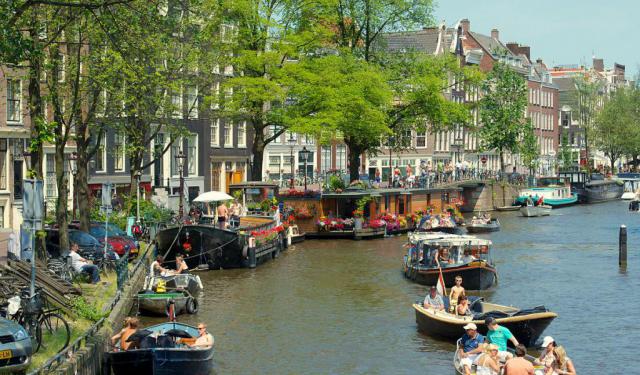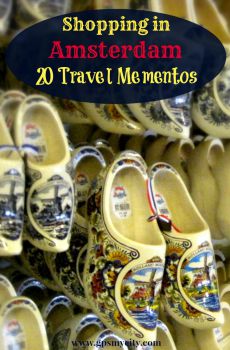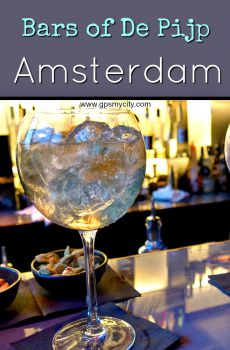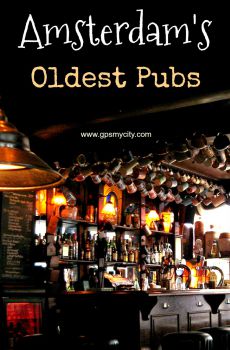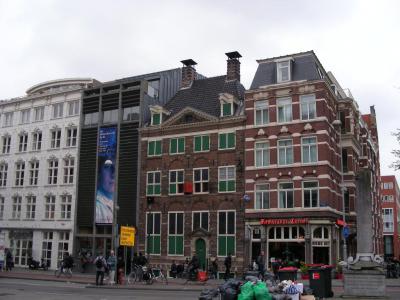
Museum Het Rembrandthuis (Rembrandt House Museum), Amsterdam (must see)
This old house in Amsterdam's Jews Broadway, with an ornate facade adorned with intricate wooden shutters and an elaborate pediment, was once the home and studio of the Dutch painter Rembrandt van Rijn. Commonly known as Rembrandt, he was a prominent 17th-century figure, rightfully acclaimed as one of the foremost artists of the Dutch Golden Age—a period when the Dutch Empire enjoyed the zenith of its power and renown.
Originally built in 1606, the property served as the artist's residence during the pinnacle of his fame, a place where he resided for nearly two decades, from 1639 to 1658, and created some of his most iconic masterpieces, such as "The Night Watch."
However, the lavish expenditure on furnishings ultimately contributed to Rembrandt's financial downfall. After his bankruptcy, the house changed hands and underwent various renovations before it was purchased by Amsterdam's municipality, in 1907, and then restored and converted into a museum by 1911. The building was redesigned in the 20th century based on the inventory drawn up during Rembrandt's bankruptcy.
The museum shows Rembrandt's living and working quarters, giving the visitor an idea of the artist's daily life. Stepping inside here feels akin to entering one of Rembrandt's own paintings, with quintessential Dutch interiors featuring black-and-white tiled floors and traditional box beds. Two particularly captivating highlights include a nearly complete collection of Rembrandt's etchings, exhibited in its modern wing and etching cabinet. In Rembrandt's old house, there are also works of art by his teacher, Pieter Lastman, and his pupils, Ferdinand Bol and Govert Flinck. The museum also hosts temporary exhibitions throughout the year of the works by Rembrandt's contemporaries and (contemporary) followers.
In 2019, research confirmed that two pots found in Rembrandt’s old cesspool were used by him for mixing quartz soil, a unique canvas preparation method. These pots are now on display here.
Tip:
Reserve some time to browse the museum's quaint shop, offering a selection of delightful, high-quality souvenirs at reasonable prices. It is highly likely that you will want to get something as a keepsake for yourself too.
Originally built in 1606, the property served as the artist's residence during the pinnacle of his fame, a place where he resided for nearly two decades, from 1639 to 1658, and created some of his most iconic masterpieces, such as "The Night Watch."
However, the lavish expenditure on furnishings ultimately contributed to Rembrandt's financial downfall. After his bankruptcy, the house changed hands and underwent various renovations before it was purchased by Amsterdam's municipality, in 1907, and then restored and converted into a museum by 1911. The building was redesigned in the 20th century based on the inventory drawn up during Rembrandt's bankruptcy.
The museum shows Rembrandt's living and working quarters, giving the visitor an idea of the artist's daily life. Stepping inside here feels akin to entering one of Rembrandt's own paintings, with quintessential Dutch interiors featuring black-and-white tiled floors and traditional box beds. Two particularly captivating highlights include a nearly complete collection of Rembrandt's etchings, exhibited in its modern wing and etching cabinet. In Rembrandt's old house, there are also works of art by his teacher, Pieter Lastman, and his pupils, Ferdinand Bol and Govert Flinck. The museum also hosts temporary exhibitions throughout the year of the works by Rembrandt's contemporaries and (contemporary) followers.
In 2019, research confirmed that two pots found in Rembrandt’s old cesspool were used by him for mixing quartz soil, a unique canvas preparation method. These pots are now on display here.
Tip:
Reserve some time to browse the museum's quaint shop, offering a selection of delightful, high-quality souvenirs at reasonable prices. It is highly likely that you will want to get something as a keepsake for yourself too.
Want to visit this sight? Check out these Self-Guided Walking Tours in Amsterdam. Alternatively, you can download the mobile app "GPSmyCity: Walks in 1K+ Cities" from Apple App Store or Google Play Store. The app turns your mobile device to a personal tour guide and it works offline, so no data plan is needed when traveling abroad.
Museum Het Rembrandthuis (Rembrandt House Museum) on Map
Sight Name: Museum Het Rembrandthuis (Rembrandt House Museum)
Sight Location: Amsterdam, Netherlands (See walking tours in Amsterdam)
Sight Type: Museum/Gallery
Guide(s) Containing This Sight:
Sight Location: Amsterdam, Netherlands (See walking tours in Amsterdam)
Sight Type: Museum/Gallery
Guide(s) Containing This Sight:
Walking Tours in Amsterdam, Netherlands
Create Your Own Walk in Amsterdam
Creating your own self-guided walk in Amsterdam is easy and fun. Choose the city attractions that you want to see and a walk route map will be created just for you. You can even set your hotel as the start point of the walk.
Amsterdam's Historical Churches Walking Tour
The history of Amsterdam is deeply intertwined with its religious heritage. The city is home to several historical churches, each with its own unique charm and significance. These religious sites serve as both spiritual centers and architectural treasures that provide insight into the city's past.
Our walk starts in the Central Station area and leads you to visit the eight most prominent... view more
Tour Duration: 2 Hour(s)
Travel Distance: 3.8 Km or 2.4 Miles
Our walk starts in the Central Station area and leads you to visit the eight most prominent... view more
Tour Duration: 2 Hour(s)
Travel Distance: 3.8 Km or 2.4 Miles
Jordaan Walking Tour
The Jordaan district of Amsterdam is a popular neighborhood renowned for its charming, narrow streets, quaint courtyards, and picturesque canals. Replete with beautiful historic houses, many of which have been converted into cozy cafés, trendy boutiques, and art galleries, this district has a distinctive atmosphere that sets it apart from other areas in the city.
The Jordaan was originally... view more
Tour Duration: 1 Hour(s)
Travel Distance: 2.4 Km or 1.5 Miles
The Jordaan was originally... view more
Tour Duration: 1 Hour(s)
Travel Distance: 2.4 Km or 1.5 Miles
Amsterdam Food Tour
Amsterdam's food scene is a delightful fusion of local traditions and global influences. Making your way through the interlocking canals, pretty bridges, and a maze of streets laden with diverse eateries and bars may easily render you hankering for a bite to eat and/or a drink to wash it down with.
The diverse culinary landscape of Amsterdam caters to a wide range of tastes and... view more
Tour Duration: 2 Hour(s)
Travel Distance: 2.6 Km or 1.6 Miles
The diverse culinary landscape of Amsterdam caters to a wide range of tastes and... view more
Tour Duration: 2 Hour(s)
Travel Distance: 2.6 Km or 1.6 Miles
Southern Canal Belt Walking Tour
The Canal District, known as Grachtengordel in Dutch, is a globally renowned example of urban planning and architectural excellence within Amsterdam. This area has remained remarkably well-preserved for over four centuries, celebrated for its charming small bridges, canal crossings, and 17th-century residences. Encircling the Old City Centre in a horseshoe shape, the Canal Ring encompasses three... view more
Tour Duration: 2 Hour(s)
Travel Distance: 3.1 Km or 1.9 Miles
Tour Duration: 2 Hour(s)
Travel Distance: 3.1 Km or 1.9 Miles
Amsterdam Introduction Walking Tour
The Dutch capital, Amsterdam, some say, “dances to its own beat.” Indeed, Amsterdam – where “hipness meets history” – has a rather unusual life rhythm and style, famously manifested in the air of legalized cannabis, coffee shops, and the Red Light District. In large part, this “air of freedom” attracts annually to the city over five million visitors.
As a small fishing village,... view more
Tour Duration: 2 Hour(s)
Travel Distance: 4.0 Km or 2.5 Miles
As a small fishing village,... view more
Tour Duration: 2 Hour(s)
Travel Distance: 4.0 Km or 2.5 Miles
Western Canal Belt Walking Tour
The Western Canal Belt is Amsterdam at its most iconic—picture-perfect and brimming with history. Part of the city’s famed Canal Ring, a UNESCO World Heritage Site, it’s a neighborhood that marries beauty and function.
Back in the 17th century, the three major canals—the Gentlemen’s Canal, the Emperor’s Canal, and the Prince’s Canal—were masterfully designed to loop around the... view more
Tour Duration: 2 Hour(s)
Travel Distance: 2.6 Km or 1.6 Miles
Back in the 17th century, the three major canals—the Gentlemen’s Canal, the Emperor’s Canal, and the Prince’s Canal—were masterfully designed to loop around the... view more
Tour Duration: 2 Hour(s)
Travel Distance: 2.6 Km or 1.6 Miles
Useful Travel Guides for Planning Your Trip
Souvenir Shopping in Amsterdam: 20 Dutch Things To Buy
Tulips, red lights, weed... Other than these, there are plenty of good things to remember Amsterdam by. What's more, you can take home some of them quite legally. Look here to see what to buy in Amsterdam and...
Bars of De Pijp, Amsterdam
Sitting to the south of the Centrum (city centre) De Pijp area of Amsterdam is a fascinating mixture of trendy urbanites, students, immigrants and Amsterdammers. De Pijp has a long history as the Bohemian part of town, which is reflected in the different cafés of the area. There truly is something...
12 Traditional Dutch Foods You Must Try in Amsterdam
Cool climate, closeness to sea, and sense of adventure have made the Dutch what they are – skillful farmers, industrious seafarers and, generally, people with the taste for life and good hearty meal, whether it comes from the sea they live by or the land they set their feet on. All of this has...
Dutch Sweets and Pastries
Known primarily for their cheeses, the Dutch have proven just as passionate about their sweets and pastries, many of which have come about as a result of the centuries of colonial past that had infused Holland with Oriental flavors and ingredients. Blended with their own dairy-rich European...
The Oldest and Historic Pubs of Amsterdam
Amsterdam is a stunningly beautiful city, steeped in history, with hidden treasures and fascinating tales practically around every corner. Like all marvelous cities, Amsterdam has its share of dining and drinking establishments from the modern to the ancient. This guide will assist you in exploring...
Top 7 Dutch Cheeses to Try in Amsterdam
Don't mind things turning a bit "cheesy" when in Holland. After all, this small country is renowned for its cheese manufacturing and successfully competes, in terms of cheese exports, with such economic giants as the United States and Germany. Amsterdam alone and its vicinities are...


